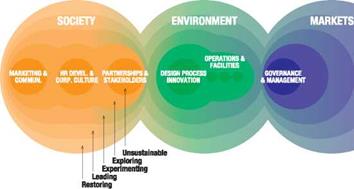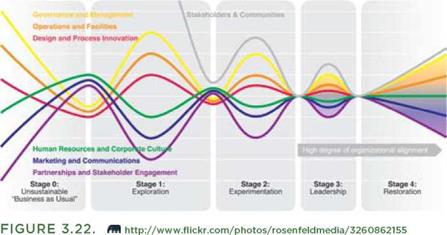The Sustainability Helix11 is the result of collaboration between Natural Capital Solutions[28] [29] and students from the Presidio School of Management.[30] It is a framework for evaluating overall organizational commitment and progress in sustainability. Unlike many frameworks, it is decidedly business-positive, and it describes a clear path from wherever an organization might score initially toward greater sustainable development, processes, and strategy (see Figure 3.21).
|
FIGURE 3.21. /Я http://www. flickr. com/photos/rosenfeldmedia/3260835281 The Sustainability Helix framework covers all domains of sustainability. |
Strengths: Business-positive and not moralizing. Neutral assessment of position along a spectrum. Promotes and contextualizes restoration, not merely sustainability. Integrates business functions throughout an organization and promotes involvement and cooperation of these over time.
Weaknesses: Lacks metrics for measurement. Subjective. [31] [32]
what the organization should aspire to achieve at that stage, and strategies for moving to the next stage. By including the lowest level, unsustainable, the helix provides all organizations with a place to position themselves on the helix, even those that have not yet considered sustainability.
The helix tracks progress in six categories of an organization’s operations and management (see Figure 3.22), allowing the organization to coordinate strategy, progress, and tactics across all functions in order to maximize the benefits and optimize the effectiveness of any given strategy
|
The Sustainability Helix (www. cmcusa. org/initiatives/ helixoverview. cfm). |
or tactic. The six categories include the following:
• Governance and Management
• Operations and Facilities
• Design and Process Innovation
• Human Resources and Corporate Culture
• Marketing and Communications
• Partnerships and Stakeholder Engagement
The third category, Design/Process Innovation, specifically addresses product and service development, but all of the categories relate to development, to some extent. Coordinating across all of them will be more powerful than confining development to its silo. Although the Sustainability Helix is more a strategic tool for corporate leadership, its framework is something all aspects of an organization, including product/service development, should be aware of, understand, and invoke in creating new solutions.
Although the Sustainability Helix is more a strategic tool for corporate leadership, its framework is something all aspects of an organization, including product/service develop – ment, should be aware of, understand, and invoke in creating new solutions. [33] [34]
• Legal: Intellectual Property Strategy Some Operations Strategies:
• Manufacturing and Production Procurement Strategy
• Sustainable Manufacturing Strategy
• Zero Waste Strategy
• Product Stewardship Strategy
• Facilities Resource Procurement Strategy
• Facilities Location Strategy
Design and Process Innovation Strategies:
• Whole-Systems Design Strategy
• Product/Service Design Strategy
• Process Design Strategy
• Testing Strategy
Human Resources Strategies:
• Optimal Utilization Strategy
• Internal Training Strategy
• Incentive Systems
• Sustainability/Risk-Taking Culture Strategy
• Cultural Alignment Strategy
• Healthy Workforce Strategy
• Diversity Strategy
Marketing and Communications Strategies:
• Sustainable Marketing Strategy
• Sustainability Education Strategy
• Internal Communications Strategy
• Public Relations Strategy
• Branding Strategy
Partnerships and Stakeholder Strategies:
• Research/Innovation/Risk Partnerships
• Regulatory Partnerships
• Human Capital Strategy (External)
• Value Chain—Customer Strategy
• Value Chain—Supplier Strategy
Most relevant to product and service developers are the list of strategies specific to Design and Process Innovation, including Whole System Design, Product/Service Design, Process Design, and Testing. These relate directly to the actions that designers can take today, described in detail next. Whole Systems Design acknowledges the need for organizations to address the full life cycle of their products and services and engage partners, customers, and other stakeholders in order to research, innovate, and reduce risk. Product/Service Design strategies seek to have developers readdress the value chain in solution development and fulfillment under the principles such as Natural Capitalism, in order to take the actions described next, resulting in more sustainable solutions. Process Design strategies seek to help developers better understand how
their processes can create incentives and realize more sustainable solutions. Lastly, Testing strategies help developers ensure that their solutions reduce impacts and are actually more sustainable.
As with the other frameworks, the detail the Helix describes requires deeper exploration, Fortunately, all of the information about the framework is available online.





